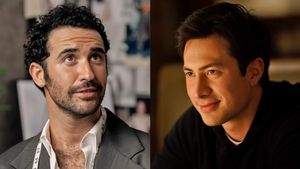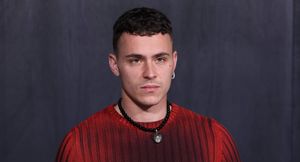(Clockwise from top right): Aisha C. Moodie-Mills, A. Cornelius Baker, Hutson W. Inniss, and Sharon J. Lettman-Hicks
In his December speech to commemorate the 23rd annual World AIDS Day, President Obama said what should be obvious to all Americans yet is not: "When new infections among young black gay men increase by nearly 50% in three years, we need to do more to show them that their lives matter."
Obama was referring to the rise in HIV infections for gay and bisexual African-American men between 2006 and 2009 -- a period when infection rates among other populations remained steady, according to figures from the Centers for Disease Control and Prevention. Recent data on African-American women, meanwhile, shows rates of infection alarmingly higher than health officials once thought.
Together, the numbers illuminate a sobering reality: Despite myriad prevention efforts, the domestic HIV/AIDS agenda has done too little, too late, both in reducing infection and ensuring access to care for communities most at risk. "When this administration came into office, our domestic HIV/AIDS strategy was basically to keep doing what we were doing," U.S. Secretary of Health and Human Services Kathleen Sebelius said in a February keynote at the White House Conference on LGBT Health. "We weren't adapting fast enough. Agencies and programs weren't working together well enough." Sounding hopeful tones in her speech that echoed the president's, Sebelius said the new National HIV/AIDS Strategy "has breathed new life into the fight against HIV and AIDS by focusing our resources on the populations that are most affected."
Yet as the administration seeks to achieve the ambitious goals laid out in the national strategy, it is met with yet another troubling reality: complacency. Far fewer Americans consider HIV to be an urgent concern today than did in the 1990s. Even the gay community's growing (and sometimes singular) focus on marriage equality, however laudable the goal, has shifted attention away from some of the most vulnerable LGBT Americans. If black Americans don't believe the larger gay and lesbian movement cares about their lives, why should they invest in it?
HIV/AIDS isn't the only health crisis facing black Americans, who also have higher rates of diseases such as diabetes and sickle-cell anemia. But understanding the real reasons for why new infections have risen dramatically has proved duly challenging. Far too often, experts and advocates say, the media have been obsessed with the "down-low" phenomenon and the false assumptions that come with it rather than concerned with how factors such as poverty and access to health care fuel the epidemic.
The Advocate recently spoke with leading experts on HIV/AIDS about how it affects African-Americans, and what both the administration and the LGBT community need to consider in order to successfully fight the disease and the stigma it sows. Here are five takeaways:
1. If you assume that the "down-low" phenomenon is the root cause of the HIV/AIDS epidemic among black gay and bisexual men, you're missing the bigger picture.
This year the White House has hosted multiple conferences nationwide on LGBT issues (not coincidentally, a campaign-year initiative) on topics including bullying in schools, poverty, and homelessness. These issues are all related to each other and to the HIV epidemic. Yet they are often passed over in media coverage for a pervasive focus on down-low culture in trying to understand the reasons why black gay men are contracting HIV at six to eight times the rate of their white counterparts. "Almost every time I hear talk about the down low, I remember the feeling of being blamed for something I did not do," Keith Boykin wrote in the 2005 book Beyond the Down Low: Sex, Lies, and Denial in Black America. "Facts are not important in this environment. Perception is reality."
Aisha C. Moodie-Mills, adviser for LGBT policy and racial justice, Center for American Progress: What we know from the research is that black MSM [men who sleep with men] are not engaging in any more risky behavior than white MSM. And so that in and of itself is not why the rates are so high. We've got to look deeper at the intersections. What we often haven't looked at are the larger structural conditions. How is the incarceration rate among all of these marginal populations contributing to the spread of this disease? How is poverty, lack of access to quality health care -- not only of treatment, but also of the ability to know your status -- contributing as well?
A. Cornelius Baker, member, Presidential Advisory Council on HIV/AIDS: We need to be absolutely clear that HIV happens to our community, because we need to be part of the solution to end it. We can't hide it under a rock. But we also need to be clear that it's not because of some hypersexuality in our communities. It's not because we're doing far more of all the bad things than any other population. When young gay men are thrown out of their homes, which is one of the leading ways that they become homeless, they're put at much greater risk for HIV. When we look at bullying in the schools and the way it marginalizes a lot of transgender people and young gay men at school -- that affects their economic progress for the rest of their lives. And that makes them much more vulnerable to HIV. There are factors that are contributing to young people, especially in the black community, not having the ability to be able to escape from a cycle of poverty and disease. And it's not solely HIV. HIV is perhaps the worst manifestation, but it's a whole lot of things that factor into HIV becoming that worst manifestation.
2. While not a panacea, health care reform would prove instrumental for improving access to HIV care among minority populations.
If it survives a U.S. Supreme Court decision, there are several reasons in the realm of HIV/AIDS why the negative connotations of "Obamacare" will be forgotten, as the president's reelection campaign currently is so zealously attempting to remind us.
Among the primary goals in the Affordable Care Act for combating HIV/AIDS, as outlined by the administration in the National HIV/AIDS Strategy, are the end of insurance discrimination based on preexisting conditions and a significant expansion of Medicaid for low-income individuals (those at 133% of the federal poverty level, or $14,483 per individual, would qualify for Medicaid). Both are extremely relevant for many African-Americans living with HIV. Currently, as a result of the law passed by Congress, insurers can't place lifetime limits on care, nor can they deny coverage to children living with HIV.
Baker: But having universal health care alone won't take away marginalization of LGBT people in health care. It won't take away substandard care around HIV alone. If that would do it, Europe wouldn't have an HIV epidemic -- and especially around gay men, which is what their epidemic primarily is, gay men and minorities. So we have to consider: What is transformative in the health care system, beyond just financing it? What can transform the quality of care? And how do we put those incentives and mandates in place?
3. The White House and Congress need to hear from LGBT Americans that HIV/AIDS remains a priority.
There are many "asks" of this administration and leaders in Congress from the LGBT community: Stop defending DOMA in court. Pass employment nondiscrimination protections. Say "I do" to marriage equality. Often, HIV/AIDS concerns are pushed lower on our list of demands. While HHS has done increasingly good work on the issue, experts want more -- and they want gay Americans to step up and speak out.
Moodie-Mills: I think that this White House absolutely gets it. What I'm seeing from HHS and from the Office of National AIDS Policy is that they understand the complexities of the issues at hand. It's not simply, "Let's add a little more to the Ryan White fund." It's actually, "How do we get rid of this disease, and what are the behavioral, structural, and other systemic conditions that perpetuate this?" But from the outside, we need to push them to move a little quicker. In my conversations with the administration, they always say to me, "We need to feel the external pressure." The challenge that I see is that we're not always doing that successfully.
Baker: This is a quantifiable issue that we know causes premature death in our community. And our tax dollars, which we do pay, do not benefit us. We have study after study showing us that the most underfunded population are gay men. So why are we passive when research and prevention dollars are not going to our community? Would we allow anything else to be killing us and be so silent about whether the federal government should be responding in kind?
Sharon J. Lettman-Hicks, executive director and CEO, National Black Justice Coalition: There is a tremendous amount of progress being made, and it's not just with HIV/AIDS. [The Department of Health and Human Services] has done an amazing job in reaching out to the full LGBT equality agenda in recognizing that there are major health issues and service issues around our community. But we can do more to be out front. The LGBT community as a whole needs to regain a priority in the conversation about HIV/AIDS, because I do believe it's been relegated to HIV/AIDS-specific organizations.
4. Good data drives policy.
In the 2011 report "The Health of Lesbian, Gay, Bisexual, and Transgender People: Building a Foundation for Better Understanding," the Institute of Medicine laid out a game plan for better serving the health needs of LGBT people. Central to that plan is a data-driven approach -- one that can show in concrete terms where American health care can better address gay and transgender health issues.
Problem is, the data on LGBT Americans isn't yet there, and as a result, there's insufficient understanding of how sexual orientation and gender identity interact with race and ethnicity in regard to HIV/AIDS and other health crises. Under Secretary Sebelius, HHS has sought to remedy this and will begin including sexual orientation questions in the 2013 version of its 100,000-respondent National Health Interview Survey (when the survey may also add gender identity questions is currently unclear). The data collected could greatly enhance understanding of how race and sexuality influence health care access and quality.
Hutson Inniss, executive director, National Coalition for LGBT Health: The importance of understanding what's happening in our communities is huge. And when Secretary Sebelius designated sexual orientation as an additional population, it was a significant step forward. This is the major work that many of us advocates and academics do. It's a move toward real change, in part because of the passage of the Affordable Care Act.
5. Marriage equality is a good thing, and so is the drive to achieve it. But this effort shouldn't keep us from addressing the needs of those living with HIV and struggling for basic survival.
On that point, Moodie-Mills notes in her January 2012 report "Jumping Beyond the Broom: Why Black Gay and Transgender Americans Need More Than Marriage Equality" that over the past decade, national LGBT groups have produced more research studies on how the political push for marriage rights benefits black gay couples than they have on any other issue affecting the community, including domestic violence prevention and employment discrimination. (Why this is the case is becoming more and more obvious as the movement works to fend off an overarching antigay strategy "to drive a wedge between gays and blacks -- two key Democratic constituencies," as leaders of the National Organization for Marriage put it in a recently released internal memo.) Advocates worry that HIV/AIDS work is falling by the wayside as a result.
Baker: Look at the trajectory of when we seriously started talking about marriage. We started seriously talking about marriage after 1996, once the treatments were out, and once we could envision a different future for ourselves. But in many communities, black gay men are in the same place where white gay men were 25 years ago.
I believe in marriage, because we shouldn't have discrimination, and it does benefit people's lives, it does help them to be healthier. But we have to look at the fact that people are struggling on many different levels. People are dying today. So it's not an either/or, it's just simply a matter of priority of the moment.
Lettman-Hicks: I really hold our LGBT organizations responsible for elevating the voice. We must see HIV/AIDS as a priority. And we need more organizations to take a stand and say that while we're not going to eliminate other priorities, we cannot allow anyone a pass on not making HIV/AIDS a priority issue amongst the larger equality agenda.
Moodie-Mills: The elephant in the room is that the top national LGBT organizations don't necessarily focus on quality-of-life issues. They're working on political expediency toward equality, and we're thankful for the work, but they're not focused on these other issues. We can't ignore the fact that there's classicism and racism within the broader LGBT movement, so once the powers-that-be and the folks who hold the purse strings can resolve their own crisis with HIV/AIDS, they're not always concerned with the people who are left behind --just as we see in broader society of marginalized people left behind. They're not doing enough, they're not addressing the needs of black LGBT people in general, let alone those who have HIV/AIDS.
But if we look at the demographic shift of America, we know that by 2042 to 2050, the minority faces are going to be the majority makeup of America. If we are not addressing the issues that impact people of color who are LGBT in the movement, then there's not going to be a movement.
Roundtable experts:
Aisha C. Moodie-Mills serves as the advisor for LGBT policy and racial justice at the Center for American Progress (CAP) in Washington, D.C. She has been recognized as one of the top "Forty Under Forty" national gay and transgender leaders by The Advocate, and as one of THE ROOT 100's emerging and established leaders in the African-American community. Aisha was a key strategist and spokesperson that in the coalition leading the marriage equality campaign to victory last year in Washington, D.C. She and her wife pen the political and lifestyle blog Living, Loving, and Laboring OUT Loud.
Sharon J. Lettman-Hicks is the executive director and CEO of the National Black Justice Coalition (NBJC), a civil rights organization dedicated to empowering black LGBT people. NBJC provides leadership at the intersection of national civil rights groups and LGBT organizations, advocating for the challenges and needs of black LGBT people and communities that are often relegated to the sidelines. NBJC envisions a world where all people are fully-empowered to participate safely, openly and honestly in family, faith and community, regardless of race, gender identity or sexual orientation.
Since 2006, A. Cornelius Baker has served as the national policy advisor for the National Black Gay Men's Advocacy Coalition, an initiative committed to improving the health and well-being of black gay men through advocacy that is focused on research, policy, education, and leadership development. In October 2006, he joined the AED Center on AIDS & Community Health as a senior communications advisor and is co-director of the Be the Generation Bridge, a project to engage communities in biomedical HIV prevention research. From 2000-2004, Baker served as the executive director of Whitman-Walker Clinic, the leading provider of prevention, treatment, research and social services to people living with HIV in the Washington, D.C. metropolitan area.
Hutson W. Inniss is the executive director for the National Coalition for LGBT Health, based in Washington, D.C. Previously, he was the vice president of community and organizational development for Tapestry Health, Inc. (a Coalition member) where he served as the project director for its Among Men/For Men Project. Inniss also served as a founding member of the Massachusetts Commission for GLBT Youth and the Pioneer Valley Coalition for Suicide Prevention.




































































Charlie Kirk DID say stoning gay people was the 'perfect law' — and these other heinous quotes